IMEHA (International Model Equine Hobbyists Association) was an online photo showing site that existing until 2018. Included on the site were these guidebooks for judging and showing model horses in Performance classes. MEPSA has obtained permission to share the info contained in the guides.
IMEHA offers the following Showmanship Classes
A Doll Handler Is Required:
Western Halter Section:
Showmanship Western Stock Breed
Showmanship Western Light Breed
Showmanship Western Pony Breed
Showmanship Western TB – WB – Sporthorse Breed
Showmanship Western Other Breed
English Bridle Section:
Showmanship English Bridle Stock Breed
Showmanship English Bridle Light Breed
Showmanship English Bridle Pony Breed
Showmanship English Bridle TB – WB – Sporthorse
Showmanship English Bridle Other Breed
Arabian Native or Arena Headstall Section:
Showmanship Arabian Native Headstall
Showmanship Arabian Cultural Headstall and Collar
Showmanship Arabian Dubai Halter
Showmanship Arabian Light Breed Style Arena Headstall
Headstall Suited to Breed Section:
Showmanship Draft Horse
Showmanship Light and Pony Breeds In Hand – No Arab
Showmanship Gaited Horse
Showmanship Baroque Breeds
Showmanship Donkey – Mule – Zebra
Suitability for Dressage
Foal or Yearling Section:
Showmanship Western Foal or Yearling
Showmanship Other Discipline Foal or Yearling
Judging IMEHA Showmanship
In the real horse world Showmanship classes are based on the handler and the horse is a prop. For IMEHA since this is a photo contest and the set ups are based on recreating as real a class entry as possible the judging is based 50% on the handler and 50% on the horse and the headstall. Handler should appear to be performing whatever the comment line is stating in the entry.
Overview for Showmanship
The exhibitor shall always lead the horse from the near (left) side.
All turns shall be to the right, with the exhibitor walking to the right around the horse. The only exceptions being the initial lineup and when excused by the judge.
The Quarter System of Showmanship
The following suggested guidelines of movement are meant to serve as an illustration of proper movement around the horse while showing in Grooming and Showmanship and are for exhibitor information.
Imaginary lines divide the horse into four equal parts as seen in the figure below. (Note: The horse has been section into four quadrants numbered I, II, III, and IV for ease of identification.) One line runs across the horse behind the withers. The other imaginary line runs from head to tail. When the judge is in I, the exhibitor should be in IV. As the judge moves to II, the exhibitor should move to I. When the judge moves to III, the exhibitor moves to IV. As the judges move up to IV, the exhibitor returns once more to I. This method is based on safety as the exhibitor can keep the horse’s hindquarters from swinging toward the judge should the horse become fractious.
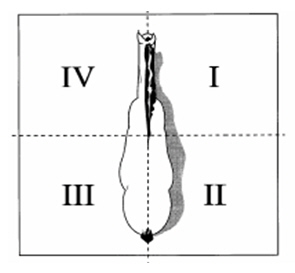
Faults against Western and English Showmen:
- Failure to recognize and correct faults in the horse’s position.
- Visiting or conversing with other contestants in the arena while showing.
- Kicking horse’s leg into position.
- Failure of the horse to lead properly.
- Failure to stop before turning when showing at the walk or trot.
- Failure to back horse when necessary.
- Loud voice commands to the horse.
- Over showing through unnecessary actions.
- Blocking the judge’s view of the horse when horse is set-up.
- Turning horse in the wrong direction.
- Causing the judge to move to avoid being bumped or stepped on by the horse.
- Improper fitting of equipment.
- Improper Attire.
- Improperly fitted or groomed horse.
- Horse’s feet not properly trimmed, shod or cleaned.
- Crowding other showmen or their horses at any time.
Western Showmanship
Attire & Tack:
Personal appearance of exhibitor should be neat, clean and well-groomed, attentive and courteous. The handler can wear a western equitation suit or pants, shirt, tie, hat, belt with buckle and gloves. Chaps are not allowed. All exhibitors are required to wear a correct number in a visible manner on the back. Western style leather halter with silver. Silver is not to count over nylon or rope halter. Halter is adjusted to fit tight under throat latch. A leather, rope or nylon lead or rope lead is used. Lead should be about 6 to 7 feet long with a 12 to 18′ chain attached to lead. The chain may be clipped under the chin, over the nose (a judge may not DQ for use of chain over the nose as a restraint but normally it is counted down and an unruly horse may be asked to leave the ring) or doubled through the “O’ ring under the chin and fed back to the leather lead and attached to chain junction. This makes the chain lead look like a double chain. The chain in NEVER clipped directly with the snap end of chain to the “O” ring under the halter. This is for two reasons: 1) The lead would be too long for the proper hold of the handler hand’s on the lead. 2) If the horse would pull back on the chain the direct pressure on the snap may cause the chain snap to break, freeing the horse in the arena to cause havoc. When the class is doubled or looped under chin or over the nose nose the snap as no pressure on it so less likely to break. The handler’s hand should be placed on the leather part of the chain junction. No whips, quirts, bats, bridles or hackamores allowed.
The chain should be adjusted so that the excess protrudes about two to six inches from the halter. The horse is lead from the left side with the hand on the lead strap about 8 to 12″ from the halter. Smaller exhibitors may need to use a longer hold on the lead strap. Hold the excessive lead strap in the left hand, either in a rounded or flatten (collapsed)figure 8 or in a round coil. All turns of the horse shall be to the right with the exhibitor walking to the right around the horse. If a judge is standing at the rear quarter of the horse the showman must be on the same side of horse as judge. If judge is standing at the front quarters of the horse the showman is on the opposite side of horse as judge. The showman never stands directly in front of horse but slightly off to one side, even when asking horse to back and reset. The exhibitor is only required to show the horse to the judge from the distance of one horse on either side of where the judge is standing but should keep in mind the audience is also viewing the class and should be attentive to the horse for the time they are in the arena. When lining up either head to tail or in the line up, the horse must be stood squarely on all four feet. The exhibitor will be required to travel his horse individually, leading the horse into whatever the pattern or request judge or ring steward asks for. Exhibitors must keep proper position in line and allow reasonable space of at least 5 feet between horses.
Western Showmanship for Stock Breeds
The judging is to be based 50% on the handler and 50% on the horse. Handler is judged on their ability to present the horse. The horse should be clean, well-groomed, attentive and in excellent physical condition and be able to walk, trot or extended trot, stop and back in a straight or curved line, as directed by the judge. Current show style is to show both the adult horses and foal with a pulled and banded mane. It is recommended to use short trimmed mane style models and keep the long maned models for breed and color classes. The horse must be kept posed and the handler must know where the judge is at all times.
The following are major faults during the class:
Failure to correct faults in horse’s position.
Visiting or talking to other exhibitor’s.
Kicking or placing the horse’s leg into position (actual contact with leg).
Touching the horse with hands or feet.
Holding the chain portion of the lead.
Changing hands on the lead, except when showing teeth.
Standing directly at the front of the horse.
Blocking judge’s view.
Failure of horse to lead properly.
Failure to stop turning when showing at walk or trot.
Failure to back horse.
Overshowing through unnecessary actions.
Turning horse in wrong direction.
Causing judge to move to avoid being bumped, stepped or run over by horse.
Improperly fitted equipment.
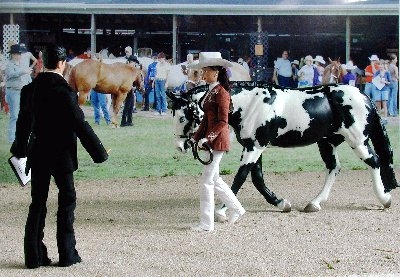
Info: Black Overo Paint Mare
Mold: Smokin HotChic by Clayton
Owner by Andrea Robbins
Comments: For safety, when the entry is in motion past the showmanship judge, the judge stays on the same side as the handler in order to avoid spooking the horse into the handler. The handler moves with her horse as she jogs past the judge, and she stays in position between the horse’s eye and halfway down the horse’s neck. The handler is holding the leather portion of the lead, which has a section of chain that runs through and under the halter and is attached to the upper side of the halter. There is a 6″ portion (in model size) of the chain between the halter and the handler’s hand.
Western Showmanship for Light Breeds
The judging is to be based 50% on the handler and 50% on the horse. Entries into this class are any light breed, such as Morgan, Arabian, Gaited, etc. that for whatever reason is showing in a western halter. All rules and attire are the same as for Western Stock Breeds. Be sure that your comment line correctly give a valid reason as to why the entry is wearing and performing showmanship in a Western halter.
Western Showmanship for Pony Breeds
The judging is to be based 50% on the handler and 50% on the horse. Entries into this class are any pony breed, such as POA, Connemara, Quarter Pony, etc. that for whatever reason is showing in a western halter. All rules and attire are the same as for Western Stock Breeds. Be sure that your comment line correctly give a valid reason as to why the entry is wearing and performing showmanship in a Western halter.

Info: Dark grey Connemara mare
Mold: Ballycor resin painted by Sherry Clayton
Shown by Robin Nere
Comments: Showing in Western Show, from line up, walk towards judge. Turn at cone and jog to center of arena.
Western Showmanship for TB, WB or Sporthorse Breeds
The judging is to be based 50% on the handler and 50% on the horse. Entries into this class are any TB, WB or Sporthorse breed, that for whatever reason is showing in a western halter. All rules and attire are the same as for Western Stock Breeds. Be sure that your comment line correctly give a valid reason as to why the entry is wearing and performing showmanship in a Western halter.
Western Showmanship for Other Breeds
The judging is to be based 50% on the handler and 50% on the horse. Entries into this class are any Other breed such that not a stock breed, Light breed or TB, WB or Sporthorse breed, that for whatever reason is showing in a western halter. All rules and attire are the same as for Western Stock Breeds. Be sure that your comment line correctly give a valid reason as to why the entry is wearing and performing showmanship in a Western halter.

Info: red Roan Tobiano MFT Gelding
Mold: Stone Palouse CCM by Sudekum
Shown by Sue Sudekum
Comments: Competing in Western Showmanship: Trot or second-gait past cone and halt. Pivot 90 degrees and walk to judge.
English Showmanship

Attire:
The handler wears the same jodhpurs or breeches and boots as they would wear in a riding class, with appropriate hunt seat or saddle seat hats, neckwear, and jackets. No short sleeve shirts are allowed.
Bridles:
English style bridle is optional mandatory.
Hunt Seat Bridle:
Hunt Seat Bridle may use an eggbutt, D-ring, O-ring or full cheek snaffle bit. Twisted, twisted wire, roller or knife edge bits and any variety or inhumane mouthpiece are not allowed.
Full Bridle, Pelham, Kimberwicke or Weymouth:
Full Bridle, Pelham, Kimberwicke or Weymouth may also be used.
The commonly used white lined dressage bridle with dropped nose band is permitted as well as a newmarket chain. Decorative bridles and silver halters are prohibited.
Leading The Horse:
The Lead has several options of which all are legal:
Snaffle Bridles:
Snaffle Bridles are led by the reins, of which are not placed over the head but instead are hanging down from the bit. The handler’s right hand will hold the reins with length long enough for handler to stand at the horse’s throatlatch. The left hand will hold the bight of the reins which may be coiled, folded or the bight resting neatly in hand.
Full Bridles:
Full Bridles option to show off either snaffle or curb; or handler may carry both reins in hand.
Pelhams, Weymouth or Kimberwicke:
Pelhams, Weymouth or Kimberwicke with four reins, option to show off either set, non-leading rein to be draped over withers in both situations Or, handler may carry both reins in hand.
Showmanship English Bridle Stock Breed
The judging is to be based 50% on the handler and 50% on the horse. Stock Horses are judged in an In-Hand Class for conformation, temperament, movement, etc. In English Showmanship the handler’s ability to exhibit the horse is also judged. In showmanship a pattern is usually given to exhibitor to follow in the same manner as a Western Showmanship class.
Showmanship English Bridle Light Breed
The judging is to be based 50% on the handler and 50% on the horse. Light Breed Horses are judged in an In-Hand Class for conformation, temperament, movement, etc. And, in English Showmanship the handler’s ability to exhibit the horse is also judged. In showmanship a pattern is usually given to exhibitor to follow in the same manner as a Western Showmanship class.
Bridles:
English style bridle is optional mandatory.
Hunt Seat Bridle:
Hunt Seat Bridle may use an eggbutt, D-ring, O-ring or full cheek snaffle bit. Twisted, twisted wire, roller or knife edge bits and any variety or inhumane mouthpiece are not allowed.
Full Bridle, Pelham, Kimberwicke or Weymouth:
Full Bridle, Pelham, Kimberwicke or Weymouth may also be used.
The commonly used white lined dressage bridle with dropped nose band is permitted as well as a newmarket chain. Decorative bridles and silver halters are prohibited.
Leading The Horse:
The Lead has several options of which all are legal:
Snaffle Bridles:
Snaffle Bridles are led by the reins, of which are not placed over the head but instead are hanging down from the bit. The handler’s right hand will hold the reins with length long enough for handler to stand at the horse’s throatlatch. The left hand will hold the bight of the reins which may be coiled, folded or the bight resting neatly in hand.
Full Bridles:
Full Bridles option to show off either snaffle or curb; or handler may carry both reins in hand.
Pelhams, Weymouth or Kimberwicke:
Pelhams, Weymouth or Kimberwicke with four reins, option to show off either set, non-leading rein to be draped over withers in both situations Or, handler may carry both reins in hand.
Showmanship English Bridle Pony Breed
The judging is to be based 50% on the handler and 50% on the horse. Pony Breeds are judged in an In-Hand Class for conformation, temperament, movement, etc. And, in English Showmanship the handler’s ability to exhibit the horse is also judged. In showmanship a pattern is usually given to exhibitor to follow in the same manner as a Western Showmanship class.
Bridles:
English style bridle is optional mandatory.
Hunt Seat Bridle:
Hunt Seat Bridle may use an eggbutt, D-ring, O-ring or full cheek snaffle bit. Twisted, twisted wire, roller or knife edge bits and any variety or inhumane mouthpiece are not allowed.
Full Bridle, Pelham, Kimberwicke or Weymouth:
Full Bridle, Pelham, Kimberwicke or Weymouth may also be used.
The commonly used white lined dressage bridle with dropped nose band is permitted as well as a newmarket chain. Decorative bridles and silver halters are prohibited.
Leading The Horse:
The Lead has several options of which all are legal:
Snaffle Bridles:
Snaffle Bridles are led by the reins, of which are not placed over the head but instead are hanging down from the bit. The handler’s right hand will hold the reins with length long enough for handler to stand at the horse’s throatlatch. The left hand will hold the bight of the reins which may be coiled, folded or the bight resting neatly in hand.
Full Bridles:
Full Bridles option to show off either snaffle or curb; or handler may carry both reins in hand.
Pelhams, Weymouth or Kimberwicke:
Pelhams, Weymouth or Kimberwicke with four reins, option to show off either set, non-leading rein to be draped over withers in both situations Or, handler may carry both reins in hand.

Info: Buckskin Tobiano American Sportpony Mare – Quarter Paint Pony Welsh B Cross
Mold: CM Breyer POA by Charlotte Donahue
Shown by Janice Williford
Comments: Lining up for inspection along rail
Showmanship English Bridle TB, WB, or Sporthorse Breed
The judging is to be based 50% on the handler and 50% on the horse. TB, WB or Sporthorse Horses are judged in an In-Hand Class for conformation, temperament, movement, etc. And, in English Showmanship the handler’s ability to exhibit the horse is also judged. In showmanship a pattern is usually given to exhibitor to follow in the same manner as a Western Showmanship class. They have manes braided in a style appropriate for their discipline, and usually have their tails either braided or pulled. Other than cleanliness, braiding, and basic show trimming of legs, muzzle, ears and a short bridle path, grooming products are kept to a minimum and excessive oils and polishes are frowned upon.
Bridles:
English style bridle is optional mandatory.
Hunt Seat Bridle:
Hunt Seat Bridle may use an eggbutt, D-ring, O-ring or full cheek snaffle bit. Twisted, twisted wire, roller or knife edge bits and any variety or inhumane mouthpiece are not allowed.
Full Bridle, Pelham, Kimberwicke or Weymouth:
Full Bridle, Pelham, Kimberwicke or Weymouth may also be used.
The commonly used white lined dressage bridle with dropped nose band is permitted as well as a newmarket chain. Decorative bridles and silver halters are prohibited.
Leading The Horse:
The Lead has several options of which all are legal:
Snaffle Bridles:
Snaffle Bridles are led by the reins, of which are not placed over the head but instead are hanging down from the bit. The handler’s right hand will hold the reins with length long enough for handler to stand at the horse’s throatlatch. The left hand will hold the bight of the reins which may be coiled, folded or the bight resting neatly in hand.
Full Bridles:
Full Bridles option to show off either snaffle or curb; or handler may carry both reins in hand.
Pelhams, Weymouth or Kimberwicke:
Pelhams, Weymouth or Kimberwicke with four reins, option to show off either set, non-leading rein to be draped over withers in both situations Or, handler may carry both reins in hand.
Setting Up the TB, WB or Sporthorse
The horse is stood up for judging in an “open” stance, in that the front and hind legs are not lined up squarely, but rather the two front legs and two hind legs are placed with one leg slightly in front of the other, so that all four legs can be seen simultaneously from the side. The head and neck are allowed to be held at a natural position, thought the handler may subtly raise or lower the head a bit to flatter the individual horse.
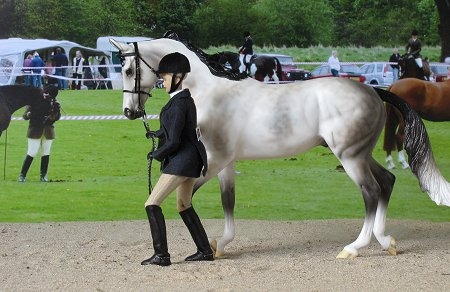
Info: Dappled Gray Thoroughbred Gelding
Mold: Stone TB Nazareth
Shown by Andrea Robbins
Comments: The contestant trots her horse for the showmanship judge.
Showmanship English Bridle Other Breed
The judging is to be based 50% on the handler and 50% on the horse. Breeds other than stock, light or TB, WB, or Sportbreed Horses are judged in an In-Hand Class for conformation, temperament, movement, etc. And, in English Showmanship the handler’s ability to exhibit the horse is also judged. In showmanship a pattern is usually given to exhibitor to follow in the same manner as a Western Showmanship class.
Bridles:
English style bridle is optional mandatory.
Hunt Seat Bridle:
Hunt Seat Bridle may use an eggbutt, D-ring, O-ring or full cheek snaffle bit. Twisted, twisted wire, roller or knife edge bits and any variety or inhumane mouthpiece are not allowed.
Full Bridle, Pelham, Kimberwicke or Weymouth:
Full Bridle, Pelham, Kimberwicke or Weymouth may also be used.
The commonly used white lined dressage bridle with dropped nose band is permitted as well as a newmarket chain. Decorative bridles and silver halters are prohibited.
Leading The Horse:
The Lead has several options of which all are legal:
Snaffle Bridles:
Snaffle Bridles are led by the reins, of which are not placed over the head but instead are hanging down from the bit. The handler’s right hand will hold the reins with length long enough for handler to stand at the horse’s throatlatch. The left hand will hold the bight of the reins which may be coiled, folded or the bight resting neatly in hand.
Full Bridles:
Full Bridles option to show off either snaffle or curb; or handler may carry both reins in hand.
Pelhams, Weymouth or Kimberwicke:
Pelhams, Weymouth or Kimberwicke with four reins, option to show off either set, non-leading rein to be draped over withers in both situations Or, handler may carry both reins in hand.
Showmanship Arabian Native Headstall
The judging is to be based 50% on the handler and 50% on the horse. The presentation of Arabian horses in their natural Arabian headstall in their natural setting. Headstall may be of halter or bridle style. Bridle may have bit, hackamore or other suitable style. Bridle may have halter-type braided headstall with one rein that turns from the left only or ornate bit with two reins. May have tassels, chains or other embellishment on it. May be of Bedouin or any region of Middle East or of Hollywood Style.
Attire
Handler is usually dressed in Arabian costume robe and can either male or female. Hollywood style attire is generally more flashy with brighter colors. Native middle east attire is more primary colors like white, red, blue, green yellow and black. Dogs, birds, cheetahs, and other props of Middle Eastern culture are often seen.

Showmanship Arabian Cultural Headstall and Collar
The judging is to be based 50% on the handler and 50% on the horse. The class is for Arabian horses in their cultural styled Arabian headstall and matching chest collar in a natural setting, advertisements setting, or a ceremonial or specialized show setting. May be a bridle with have bit, hackamore or other suitable style. Bridle may have halter-type braided headstall with one rein that turns from the left only or ornate bit with two reins. May have tassels, chains or other embellishment on it.

May be of Bedouin or any region of Middle East or of Hollywood Style.
Attire
Handler is usually dressed in Arabian costume robe and can either male or female. Hollywood style attire is generally more flashy with brighter colors. Native middle east attire is more primary colors like white, red, blue, green, yellow and black. Handlers may also wear either a variation on a business suit (basically a business suit that allows freedom to run, plus a full range or arm movement, does not show dirt and is easily cleaned, plus paddock boots or dark running shoes) or saddle seat riding attire, though usually without the long coat. White dress shirt with cumberbun style belt, dark dress slacks and dark paddock boots are also allowable.
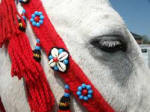
Showmanship Arabian Dubai Halter
The judging is to be based 50% on the handler and 50% on the horse. The class is for Arabian shown in the Dubai style halter in a natural setting, advertisements setting, or a ceremonial or specialized show setting. Typically has braided silk cord or woven pattern cheek pieces with tassels or other embellishment on the cheekpieces. A nosepiece of small link chain with embellished hanging chain decorations such as mini daggers. A lead that matches the woven style and coloration of the cheekpieces. The chain lead is not allowed to come to a straight “v” but as a sliding keeper on it. This is for safety reasons so the horse can not rear up and get a foot through the lead.


There is no throat latch on this style headstall. Scenes using this headstall are typically at shows held in Dubai (not is USA where there is a mandatory throatlatch required), in advertisements, stallion service auctions, and photo opportunities.
Attire
Handler is usually dressed in Arabian costume robe and can either male or female. Hollywood style attire is generally more flashy with brighter colors. Native middle east attire is more primary colors like white, red, blue, green, yellow and black. Handlers may also wear either a variation on a business suit (basically a business suit that allows freedom to run, plus a full range or arm movement, does not show dirt and is easily cleaned, plus paddock boots or dark running shoes) or saddle seat riding attire, though usually without the long coat. White dress shirt with cumberbund style belt, dark dress slacks and dark paddock boots are also allowable.
Showmanship Arabian Light Breed Style Arena Headstall
The judging is to be based 50% on the handler and 50% on the horse. The entry must be in an arena setting. Arabian Showmanship requires an Arabian Light Breed style halter is a very fine, thin show halter with minimal decoration, designed to show off the refined head that is a characteristic of the breed. The halter has a mandatory throatlatch. The chain goes under the chin and is clipped back to the lead. The length of the chain is normally about 12″ so there is some double backed length that hangs down but not enough as to make it dangerous and allow a horse to rear and get a front foot through the part of the chain that hangs down. Throatlatches may be loose or tight but do not as much as in Native Arabian Headstalls. If you can get more than 2 fingers through the throatlatch chain it is too loose.
The conformation stance for the breed is to have the front feet square and the back feet parted so that one leg is set perpendicular to the ground, and the other slightly behind it, in order to tighten and flatten the relatively horizontal croup and show off the high-set tail that are breed characteristics. The head is carried high and the neck stretched out. Class procedure is similar to the action breeds, with somewhat greater emphasis on the stand-up for individual presentation.
Attire:
Handlers wear either a variation on a business suit (basically a business suit that allows freedom to run, plus a full range or arm movement, does not show dirt and is easily cleaned, plus paddock boots or dark running shoes) or saddle seat riding attire, though usually without the long coat. White dress shirt with cumberbun style belt, dark dress slacks and dark paddock boots are also allowable. Handlers may carry a whip.

Info: Bay Arabian Mare
Mold: Aisha
Shown by Donna Miller – Shannon
Comments: Engaging horse’s attention in preparation for judge’s inspection in in-hand class.
Showmanship Draft Horse
The judging is to be based 50% on the handler and 50% on the horse. Stallions under eight months of age or mares and geldings of any age are eligible for show. The horse should be presented in a thrifty, well-cared-for condition, neither thin nor excessively fat. The animal should be clean. Tails may be natural or docked, braided or left long, but fit to the proportions of the horse. Manes may be rolled and decorated. Feet may be shod or unshod, but should be properly trimmed and clean. Black or natural hoof paint is acceptable. Halters and leads may be of leather, nylon or rope and should be clean and fitted to the horse. Show sticks and bridles will be allowed.
Class Procedure:
Horses will enter the ring at the trot and line up side by side at the direction of the ring steward. Horses will be pulled from the line, walked to the judge or ring steward, walked to the opposite end of the arena (to the ring steward or judge), turned, and trotted back to the starting point. The turn at the far end of the arena should not be over the horse’s hocks, but a slightly widened arc that results in the horse facing the opposite direction in line with the judge and ring steward when the turn is completed. The exhibitor should concentrate on keeping the horse on a straight path between the judge and ring steward for as long as possible but still leave room for the turn. Turns should always be away from the exhibitor when possible and/or feasible. After showing horse on the move, stop the horse and set the horse up. Return to the line after the judge excuses horse. Horses should be shown with all four feet positioned correctly under the body while in line. The judge will closely inspect and may handle each horse. A trailer (person to assist with moving the horse) with or without a whip is permitted. The trailer should cross to the opposite side prior to the turn and should never get between the judge and the horse when the horse is in line, but should stand behind the exhibitor some distance away and may assist in keeping the horse alert. Deviations from this description may be necessary, and will be announced prior to the beginning of the class.
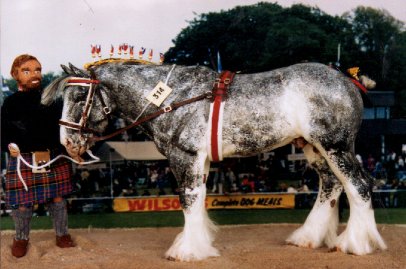
Stallions wear what is termed a “stud bridle” which is adjustable white leather with a snaffle bit and a chain under the chin. Mares, geldings, and foals are normally shown in draft breeds show halter with no bit. The chain runs under the bars of the jaw instead. However (there are always exceptions and different breeds are listed below.) A rope halter is allowable in some breeds for their mares, geldings and foals. The rope halter is one solid length of rope that makes up the halter and revolves into a lead. Some breeds display their stallions in stud tack (a surcingle usually made of leather and bridle with side reins with or without a crupper. The belt itself goes around the barrel where the girth of a saddle would fit and can be black, brown or white. This is not seen in Belgians or Percherons any longer.
Handlers wear dark pants and white shirts (no flashy clothes)

Mares are normally left natural, but in pulling contests the manes are sometimes roached along with the forelock. Almost all American drafters have docked tails. Hoof black is used in most breeds except Clydesdales, even on horses with white feet. Long tails from horses in UK should not be penalized, but the tail should be plaited in some manner, not just hanging loose. Draft mares shown in hand only have their tails braided (no mane decorations) Male horses have their manes rolled and their tails braided for halter showing. The forelock is combed and left natural or can can braided into a single strand with a ribbon tied in a small bow at the end. The roll at the start of the mane following the bridle path and continues down the neck until just above the withers. The bunting can be long enough to almost reach the horse’s elbow. Rosettes made of crete paper, ribbon, fake silk or plastic flowers (usually tulips or rosebuds) with floral wire “stalks” are placed in the mane roll. Seven rosettes is the norm, maybe 5 to 9 in certain cases, but always an odd number for symmetrical look. In England and especially on the Suffolk breed is the continental braid. The braid runs along the bottom of the mane and is the same as “French braiding” human hair. There is usually a light colored bunting that matches closely or complements the horse’s mane color plaited into the braid. All tails are braided for showring in harness and halter. The tail of a correctly braided horse (docked version) looks like a woman’s bun hairdo. The tail is then decorated with ribbons that match the mane decorations. England outlawed docking of horse’s tails , so instead you will see the tail braided from the top down in a hunter fashion or the tail bone shaved except for a fringe a the dock which is braided in the traditional tight bun and decorated with ribbons. Occasionally you will see a draft breed with long flowing tails with bows a the dock for ornamentation.
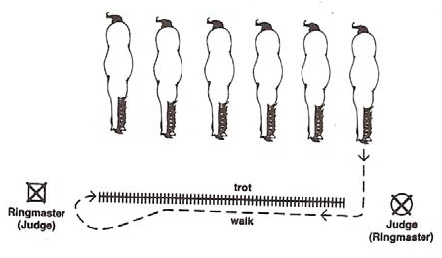
Rolled manes for harness for rolled shorter than halter or in hand showing. Referred to as “breaking off before the harness bed” Manes are decorated with 5 rosettes for harness regardless of sex. It is common to see mares, geldings and stallions in 6 and 8 horses hitches, hence the need for uniformity.
British Drafters are shown with a satin ribbon around the neck just before the shoulders with the horse’s show number on it. British horses cannot have docked tails. Germany no longer allows tail docking and the Belgian horse society of Europe has also ruled against the practice. European and Canadian Draft Association and Dr. Sharon E. Cregier of the Equine Behaviour Forum would like to remind us of the cruelty associated with docking and its complete unnecessity.
The tack is usually much more ornate than the USA as well.
Percherons are normally shown in white leather. Stud tack is not used, black or tan is not used. Facial hair and lower legs are trimmed. hoof black is used. A show stick is permissible. White rope halters are allowed on foals, mares and geldings.
Shires are shown in the “normal” fashion listed above with the exception that black, brown or fashionably trimmed tack is used and white is not seen in the show ring.
Suffolks are shown in white tack and mane is rolled in plaited French braid.
American Belgian shown in white leather and stallions do not use the surcingle. A tuft of hair is left at the ankle and down the pastern to the back of the hoof and rest of leg is trimmed. Show sticks allowed as are whippers (a second person who runs behind the horse to make it move out.)
Brabant show in surcingle and white or black leather is used.
Clydesdales are shown in a white rope, natural rope or leather halter or stallion bridle (white or tan) Stallions may show in surcingle. Leadlines should match halter. Mares, geldings and foals show in rope halters or leather draft halter. Mares and gelding may use a bridle as well. Muzzle and eye hairs are trimmed, long hair under jaw and on belly not trimmed. A bridle path is not required. Any horse over 2 years old is shod. Stallions/geldings have rolled manes and tails, mares and foals with tail braids only. Mare’s mane is usually plaited for the Royal show in Toronto but this is the only show i which they are so decorated. No hoof blacking allowed. No show sticks or whips or whippers allowed.

Showmanship Light and Pony Breeds
The judging is to be based 50% on the handler and 50% on the horse. Light Breeds such as Morab and the National Show Horse, as well as part-Arabian pinto horses, do not have any braiding or banding that interferes with a naturally long, free-flowing mane and tail. (Unless specifically shown as sport horses, then hunter-style braiding and presentation is permissible). The conformation stance is to have the front feet square and the back feet parted so that one leg is set perpendicular to the ground, and the other slightly behind it, in order to tighten and flatten the relatively horizontal croup and show off the high-set tail that are breed characteristics. The head is carried high and the neck stretched out. Class procedure is similar to the action breeds, with somewhat greater emphasis on the stand-up for individual presentation. They are presented in a very fine, thin show halter with minimal decoration, designed to show off the refined head that is a characteristic of the breed. Handlers usually wear similar attire to those showing action breeds, though some instead choose to wear Western-style attire. They are as extensively groomed as the action breeds, though manes and tails are never clipped or artificially enhanced, other than the clipping of a bridle path. And ponies are generally shown in light breed halter with mandatory throat latch. Handlers wear conservative clothing of dark pants and white shirt or blouse and paddocks boots. Hat is not required.
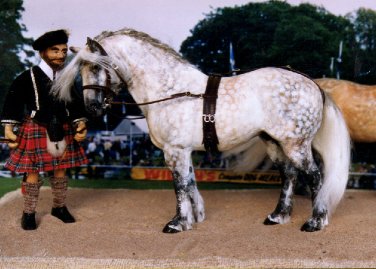
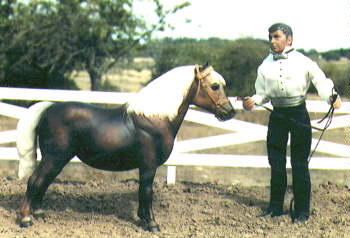
Showmanship Gaited Horse
The judging is to be based 50% on the handler and 50% on the horse. Horses are generally shown with the curb bit portion of a saddle seat style double bridle, or in a very thin, refined show halter, usually of black or patent leather with a colorful noseband (and, sometimes, browband). Usually the forelock and one or two sections of the mane has a brightly colored ribbon braided into it, and false tails are permitted. Clipping styles vary by breed and by discipline within some breeds, but proper clipping is an art form and far more extensive than for the sport horse or stock breeds. Action breeds are groomed extensively with silicone sprays on the coat, oils to add shine to the face, and hoof polish common.
ASB are normally shown with a bridle or leather show halter on a long lead. Halter chain may be placed any way, but usually seen over the nose. Snaffle bits used in younger horses, curbs used for horses 2 years and up with a single rein or full double bridle with both reins pulled down and lead jointly. Handlers should be dressed conservatively. Two handlers permitted at the trot (header and tailer.) Handlers may carry a whip.

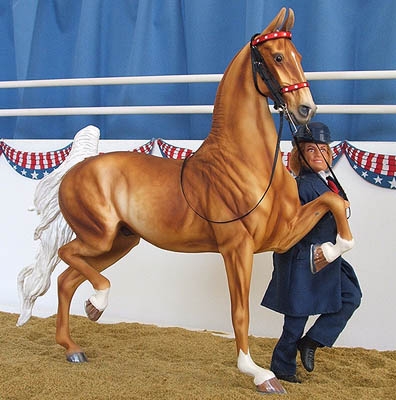
Info: Palomino Saddlebred Gelding
Mold: Trad. AR Haute Aire
Shown by Donna Miller – Shannon
Comments: In-hand class pattern 1: horse has been trotted the length of the rail and is returning to be judged.
MFT wear a show halter or bridle (regardless of gender or age) foals wear a show halter. Bridles should be of the browband type. Cavessons are optional, but it is customary to use one. Browbands and nosebands typically match the color of the ribbons, currently white is the popular color used. When a bridle is used, grazing, snaffle, curb, and halfbreed bits are permitted, but Walking Horse S-curbs are the most common. An occasional Western curb is seen. Curb chains are permitted. Handlers typically wear suits, often with contrasting yokes and cowboy hats. Women typically wear slacks, dress shirt and a coordinating vest or short jacket. Whips are permitted.

TWH wear a Walking Horse Bridle with a single rein. Colored browbands are considered appropriate, but rhinestones are forbidden. Weanlings and yearlings are shown in a light breed show halter. Handlers wear habits or suits. Foal handlers wear a collared shirt (long or short sleeves) and tie. Hats are recommended during evening performance, caps and hats are optional during the day. Handlers may carry a whip.
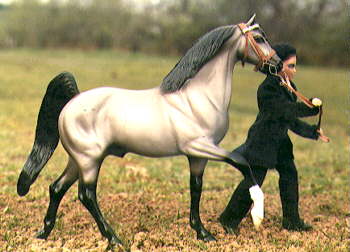
NSH may or may not exhibit gaits. But usually a NSH with or without Saddlebred gaits is shown in a light breed show halter with chain under the jaw.
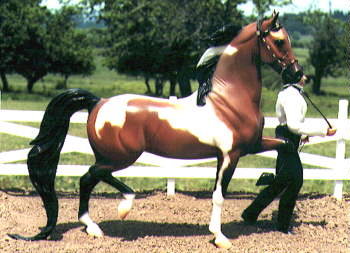
Attire
Handlers usually wear either a variation on a business suit (basically a business suit that allows freedom to run, plus a full range or arm movement, does not show dirt and is easily cleaned, plus paddock boots or dark running shoes) or saddle seat riding attire, though usually without the long coat. Handlers may carry a whip.
Showmanship Baroque Breeds
The judging is to be based 50% on the handler and 50% on the horse. The Baroque horse breeds such as the Friesian, Andalusian and Lipizzan, usually are shown in styles similar to what is done with each breed in Europe, in that clipped bridle paths and excessive greases or oils are avoided. Manes and tails are generally left loose and flowing.
Tack
They are usually presented either in a hunter or harness-style show bridle or in a halter similar to those used by Arabians, but sized heavier, depending on breed and part of the country in which the breed is shown. The horse is stood up for judging in an “open” stance, in that the front and hind legs are not lined up squarely, but rather the two front legs and two hind legs are placed with one leg slightly in front of the other, so that all four legs can be seen simultaneously from the side. It is often referred to as the pyramid stance and is also used by Thoroughbred, Warmbloods, Sporthorses and most breeds in the UK. Baroque horses are judged strongly on movement and athleticism.
Attire
The handler usually dresses neatly, but casually, often wearing a polo shirt and khaki pants, with running shoes. Dress pants, dress shirt, sweater vests and dress boots are also acceptable.
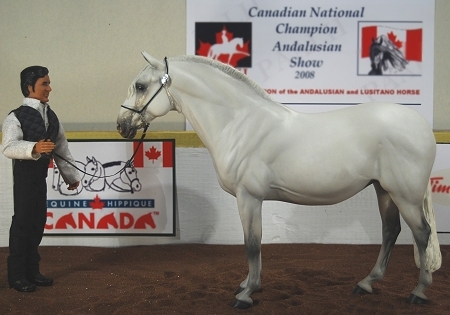
Info: White-grey Andalusian aged broodmare
Mold: Eberl “Esperanza” CM by Lexie Lawrynovicz
shown by Kim Carter
Comment: The horse should stand with front legs square. Back legs should be positioned either square or with one slightly behind the other. The horse should not be stretched.
Longear Showmanship
The judging is to be based 50% on the handler and 50% on the mule, donkey, zebra or exotic. Mules and donkey typically show in plain leather stock halters but silver is also allowed. Leads are usually leather with a chain lead that is placed under the chin, over the nose or doubled and clipped back to lead. Jacks must show in a stallion halter with chain over nose. Handlers wear clean levis or pants, boots, western style long sleeves shirt, tie and hat.
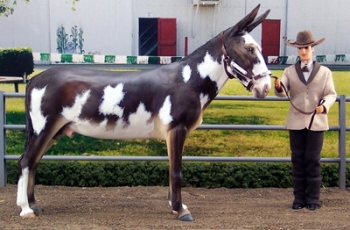
Suitability for Dressage
The judging is to be based 50% on the handler and 50% on the horse. Horses are judged (not the handler) individually on a triangle course. The horses approach the judging area and set up for inspection in an “open” position with all four legs visible by the judge standing on either side of the horse. At the judge’s request the horse will then walk a small triangle ABCA. The horse will continue on at a trot following the larger ADEA. At the completion of the judging the handler will lead the horse away from the judging area. As one horse leaves the next one will enter the judging area promptly. When all horses in class have completed the triangle course they may be lined up for judge’s to place, or “ringing” (walking in a large group circle around the judge) may used. Scoring system is 60% movement, 30% conformation, 10% temperament.


Showmanship Western Foal or Yearling
This showmanship class is open the western halter style of showing a suckling, weanling or yearling. Stock horses breeds show in western halter. The use of chain under the chin, over the nose or doubled and clipped back to lead is allowed. No chain lead is allowed to be clipped directly to the “O” ring under the chin on the halter.
Showmanship Classes: The handler is judged as 50% of the class premium and the horse’s conformation, breed type and gender plus photo quality make up the other 50%. Handlers wear attire appropriate for the breed.

Photo Credit: Little Raven
Info: Black Appaloosa filly
Mold: PS Misdemeanor Weanling
Shown by Joanna Richardson
Comment Line:
“Handler works on squaring up the foal to present to the judge while the handler stands on opposite side of foal so that judge has unobstructed view.”

Info: Buckskin Appaloosa filly
Mold: PS Coco Weanling
Shown by Joanna Richardson
Comment Line:
“Handler is quietly putting pressure on the lead to back the filly up while giving his attention to judge. This will make the filly step back one step to square up her hind legs. All the while the handler is presenting the filly to the judge. Note other shower has allowed her filly to ‘step forward behind’ out of the squared stance. She needs to stand her foal up before that judge approaches her next.”
Showmanship Other Discipline Foal or Yearling
This Showmanship class is open to all styles of showing a suckling, weanling or yearling. Light breeds show in a light breed halter. TB, WB, Sporthorse or other young horse breed that requires control show in plain leather or nylon halter. They may also show with a chiffey bit attached to the halter at 6 months through yearling year. The use of chain under the chin, over the nose or doubled and clipped back to lead is allowed. No chain lead is allowed to be clipped directly to the “O” ring under the chin on the halter.
Showmanship Classes: The handler is judged as 50% of the class premium and the horse’s conformation, breed type and gender plus photo quality make up the other 50%. Handlers wear attire appropriate for the breed.
Please see the Presentation Classes for more information concerning fitting the halter or headstall.
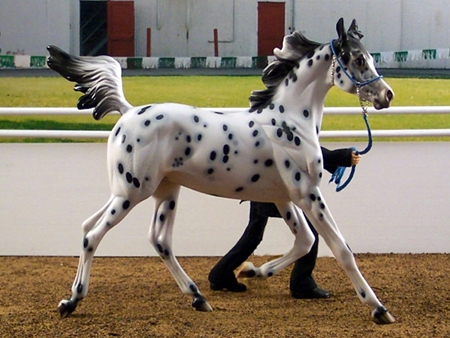
Info: Leopard Araloosa (Arabian x Appaloosa) filly
Mold: PS SR Calliope
Shown by Robin Nere
Comments: From line up, Ari is trotted to judge for inspection
Photo Credits:
Arabian Native Headstall: DA Sidi Bishiir, Arabian Stallion, doll, horse and costume by Karon Grieve and owned by Karon.
Arabian Arena Headstall: Khasmir, horse by Cary Nelson, headstall by Cynthia Jameson, Doll by Traci Durrell-Khalife, owned by Cynthia Jameson.
Draft In Hand:
Light Breed & Pony In Hand:
Gaited In Hand: DA Deca Dance, horse, doll and bridle by Karon Grieve and owned by Karon Grieve
English Showmanship or In Hand: Shanglang, BHR Hunter CM’d by Chris Nandell, bridle by Elaine Sulser, doll by Cynthia Jameson and owned by Cynthia Jameson.
Suitability for Dressage: Shangalang, doll by Traci Durell Khalfie, owned by Cynthia Jameson.
Longear In Hand Male (Jack or Stallion): Lots of Moxie, Info: Spotted Mammoth jack, Mold: AR by Carol Herden.
Draft: DA Lugton Lad, Shire Stallion in British Style showmanship owned by Karon Grieve.
Highland Pony Stallion: Shown in Traditional dress. Set up and owned by Karon Grieve.
NSH: Fernwood Fancy Free owned, tack and doll made by Traci Durrel Khalife.
MFT: Mardi Gras owned by and tack & doll made by Traci Durrel Khalife.
TWH: Lewie Prima owned by and tack and doll made by Traci Durrel Khalife.
WB: Virtual Reality: Trakehner CM’d by Karen Gerhardt, owned with doll and tack by Traci Durell Khalife.
Foundation Shetland Mare: Crescent Moonbean owned and tack and doll by Traci Durell Khalife.
Clydesdale Foal: Highland Lass owned with tack by Traci Durrel Khalife.
Clydesdale Gelding: Jumpin Kack Flash owned by with tack and doll by Traci Durrell Khalife.
Belgian Brabant Stallion: Le Roi de Liege, tack and doll by Traci Durrell Khalife and owned by Traci.
